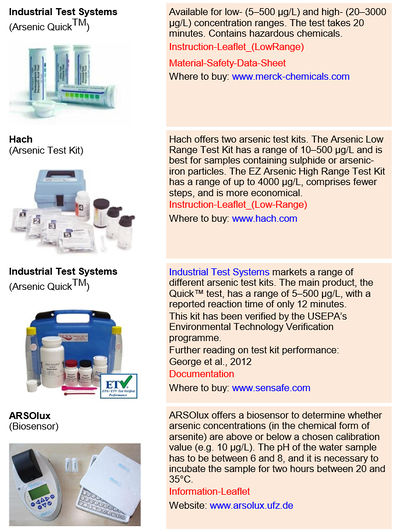Water sampling and analysis - Arsenic
NOTE: Article from the Geogenic Contamination Handbook
Inorganic arsenic in groundwater is found in two different oxidation states: As(III) (arsenite) and As(V) (arsenate). There are also organic forms, but these are rare in drinking water. Both As(III) and As(V) are toxic, but the two species behave somewhat differently in the environment. The testing methods described in this manual give total inorganic arsenic concentrations, which are adequate for most general purposes. Specialised techniques are needed to tell whether arsenic is present as arsenite or arsenate. The detection range of interest is 10 to 50 µg/L (the typical range of national standards for arsenic). Maximum concentrations of naturally occurring arsenic in groundwater can exceed 1000 µg/L.
Contents
Sampling and preservation
If a sample is to be taken back to the laboratory, its volume should suffice for at least 5 arsenic analyses. The sample bottles should be filled to the top. The sample ID should be written on the bottle, or better still, on a label stuck on the bottle, with a waterproof pen BEFORE the sample is taken. A leaky sample bottle can render labels unreadable.
High density polyethylene (HDPE) plastic bottles are recommended. They should be washed with acid (1% HCl) and well rinsed with distilled water (3 times) before use. Water samples should be transported and stored in a cool, dark and clean environment. If the samples are properly preserved, the arsenic measurements will still be reliable even if carried out several months after sampling (This is important when samples are collected for quality checking in a reference laboratory).
To avoid the formation of iron (oxy)hydroxide in the sample (orange colouring commonly associated with groundwater containing iron), which may remove arsenic from solution, the pH of the samples should be reduced to below 2 using acid. Nitric acid is commonly used (hydrochloric acid is another option); the acid should be certified to contain essentially no arsenic. Blank samples (distilled water with and without acidification) should always be tested to ensure that no arsenic is added to the samples along with the acid or the sample bottles. Generally it is sufficient to add 0.2–1% of the filling volume (e.g. 0.2–1 mL acid for a 100 mL sample bottle) of concentrated nitric acid (65%). For safety reasons, it might be advisable to use diluted acid (1:1 or 1:2) in the field. Water samples can be filtered before acidification (through 0.45 µm filters) to remove any particles that might dissolve arsenic at low pH, which would lead to higher arsenic readings. Filtration increases the precision of the results, as the particulate content is difficult to control. However, if particulate arsenic also contributes significantly to arsenic exposure, then filtering samples will lead to an underestimate of actual exposure. Generally, filtered samples are better for understanding geochemistry, while unfiltered samples are better for public health purposes.
Field test kits
Bacterial biosensors may offer another alternative for the detection of arsenic contamination in drinking water (Trang et al., 2005). These sensors, which rely on genetically engineered E. coli bacteria that glow when exposed to arsenite, are cheap and easy to use but require some training. The microbiological arsenic test has a great potential in large screening campaigns (see ARSOlux, Table 4.1).
Arsenic analysis in the laboratory
All laboratory analyses must be performed by experienced laboratory staff.
There are various methods of quantifying arsenic concentrations in the laboratory. In order of increasing sophistication (and cost), they are the colorimetric method requiring a (spectro)photometer that uses silver diethyl-dithio-carbamate (SDDC), Anodic Stripping Voltammetry; Graphite Furnace Atomic Absorption Spectrophotometry (GF-AAS); Flame AAS with Hydride Generation apparatus (HG-AAS) and inductively coupled plasma mass spectroscopy (ICP-MS). For a detailed review, see Rasmussen and Andersen (2002).
Other semi-quantitative field test kits
The Asia Arsenic Network, an early player in arsenic testing and kit development, continues to market an inexpensive kit with a range of 20–700 µg/L in Bangladesh. A variation on this kit, measuring arsenic from 10–500 µg/L, was developed by the Environment and Public Health Organization, Nepal.
A joint project between UNICEF and the Rajiv Gandhi National Drinking Water Mission in India has developed specifications for a field kit that does not use the conventional mercuric-bromide paper. Instead, a detector tube is filled with a granular medium coated with a secondary colour reagent that reacts with arsenic and mercuric bromide to produce a pink colour. Following completion of the test, the arsenic concentration (10–110 µg/L) is read directly by measuring the extent of pink colour penetration in the detector tube. Specifications for the kit are available from the Rural Water Supply Network.
UNICEF also supported the development of locally manufactured arsenic test kits in China, Thailand and Vietnam, and in China and Thailand, they are still in use. The Thai kit, developed and marketed by Mahidol University, has a detection range of 5–500 µg/L and is used in Thailand and in other countries in the region.
References
For references, please visit the page References - Geogenic Contamination Handbook.

